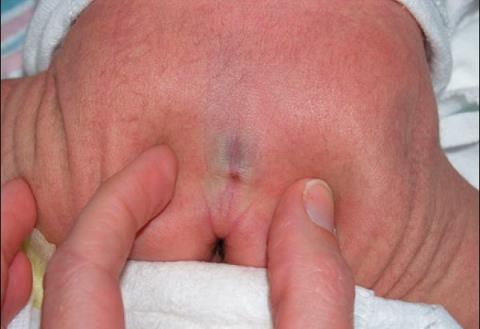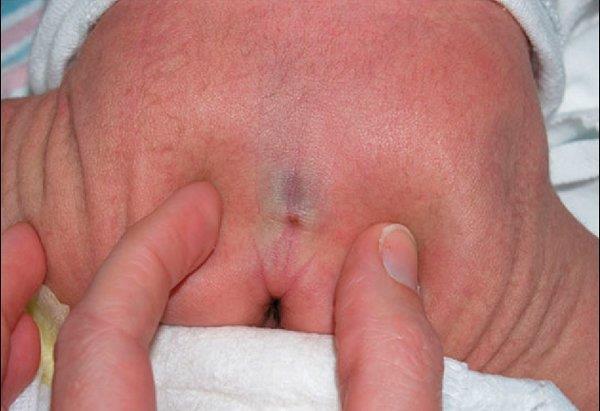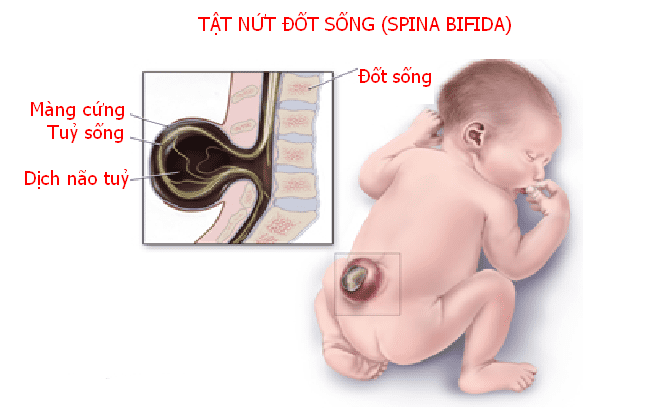What is a sacral dimple? Does it affect health?

A sacral dimple is a dimple that is present at birth, in the skin of the sacrum. It is usually located just above the fold between the buttocks. About 3-8% of the population has this indentation. Most of these indentations are not harmful and do not require treatment. A very small number of people with this indentation may have a deformity of the spinal cord. Equipping with the basic knowledge about this stump will help to relieve your questions and worries. So, let's find that information with SignsSymptomsList in the following article!
content
- 1. What is sacral depression?
- 2. Signs and symptoms
- 3. Cause
- 4. Distinguish sacral depressions and hair follicles
- 5. How is the diagnosis?
- 6. What complications can occur from sacral dimples?
- 7. What methods are used to treat sacral indentations?
- 8. Is it preventable?
- 9. How does sacral depression affect life?
1. What is sacral depression?
When your baby is born, you may see a small, shallow depression about a few millimeters in the sacrum. With that said, this dent requires almost no treatment.
In rare cases, this indentation may be related to some spinal deformity. For example, it may be accompanied by a clump of hair, an excess of skin, or some skin discoloration. Potential problems such as spina bifida, low spinal cord syndrome.
>> Jaundice is a common condition in newborn babies. Do you have a clear understanding of this situation? Learn more: Neonatal Jaundice: What to Know .
A pediatrician will look closely at this sacral dimple. Based on the size and accompanying characteristics, the doctor will see if this is a sign of an abnormality. In unusual cases, your doctor may recommend an additional imaging tool. If abnormalities are detected, treatment will depend on the underlying cause.

This is a small, shallow indentation that appears at birth
2. Signs and symptoms
The only symptom is the appearance of a dent. It is a shallow indentation usually at the end of the spine and just above the top of the buttocks.
3. Cause
Scientists still don't know the exact cause of this dent. It could be a birth defect, meaning a person is born with it. It forms for unknown reasons during fetal development. There are no risk factors for developing this dimple.
4. Distinguish sacral depressions and hair follicles
Sacral indentations can be mistaken for a hair cyst. This is because they often appear in the same places on the body, at the end of the spine and just above the buttocks. A hair cyst is a sac filled with fluid, hair, and debris. If it becomes infected, it can swell and cause pain. Sometimes pus and blood will drain from this cyst.
Sacral indentations are often present at birth. Meanwhile, hair cysts usually develop after birth. Anyone can have a hair cyst, but it most often occurs in young men. When body hair grows inwards along with excess moisture can create an environment for infection.
Illustration of a sacral hair cyst, also known as a Pilonidal cyst
5. How is the diagnosis?
Sacral dimples are easily observed by doctors when examining newborn babies. If this dent has no unusual features, it is considered a simple dent. This condition usually does not affect health. Therefore, doctors often do not have any recommendations.
If the indentation is very large or involves a tuft of hair, patch of skin, or skin discoloration, your doctor will recommend further testing. Imaging tests may be ordered to rule out spinal cord problems.
These tests may be:
- Ultrasound : This non-invasive method uses high-frequency sound waves to create images of the body's structures.
- Magnetic resonance imaging : If more detail is needed, your doctor may recommend magnetic resonance imaging. This vehicle uses radio waves and a strong magnetic field to create cross-sectional images of the body.
6. What complications can occur from sacral dimples?
In rare cases, a sacral indentation can be an underlying spinal cord defect. These can include spina bifida or low spinal cord syndrome.

Cartoon image of spina bifida in children
Spina bifida occurs when the spine does not close completely around the spinal cord. Low spinal cord syndrome is a condition in which part of the spinal cord attaches to tissue, limiting its function.
A sacral dimple should be evaluated with ultrasound or MRI if it:
- The diameter is larger than 5 mm.
- Comes with other dents.
- More than 2.5 cm from the anal opening.
- Accompanied by tufts of hair, discolored skin, or excess skin.
- This dent is deep. Which means there seems to be a hole inside this dent that you can't see the bottom of.
In a study published in the journal Archives of Childhood Diseases, dents with this feature were six times more likely to be associated with spinal cord problems than indentations alone.
7. What methods are used to treat sacral indentations?
There is no single method to treat sacral dimples. Occasionally, this dent can accumulate dirt, feces, and sweat. This increases the risk of infection or skin irritation. Keeping the area clean will reduce the risk.
If you have a sacral dimple that shows any signs of spinal cord involvement, see a neurologist. Signs of spinal cord involvement may include muscle weakness or numbness in the legs, loss of bladder or bowel control.
8. Is it preventable?
Because it is present at birth, there is no way to prevent it.
9. How does sacral depression affect life?
Surely you will be very worried when you see this unusual indentation appearing on your child's body. Rest assured, however, that your child will be examined and evaluated by a pediatrician.
Sacral dents are quite common and are usually not a problem in most cases. Rarely, they are indicative of underlying spinal cord defects. Even when those defects do occur, they are usually mild and asymptomatic. Most people with sacral dimples lead normal and healthy lives. Therefore, it does not affect your activities and lifestyle.

Most people with sacral dimples lead normal and healthy lives
The information in this article is for reference only. If you have any questions or concerns, contact your doctor immediately.
In a nutshell, a sacral dimple is a small, shallow depression. The most common location is just above the crease between the buttocks. This dent is usually harmless and does not require any treatment. However, in rare cases, it is associated with spinal cord abnormalities. Hopefully, the article provides useful information about sacral indentations to relieve readers' anxiety.
Doctor Nguyen Thanh Xuan